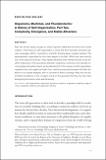Organisms, Machines, and Thunderstorms: A History of Self-Organization, Part Two. Complexity, Emergence, and Stable Attractors
Author(s)
Keller, Evelyn F
Downloadhsns.2009.39.1.pdf (279.9Kb)
OPEN_ACCESS_POLICY
Open Access Policy
Creative Commons Attribution-Noncommercial-Share Alike
Terms of use
Metadata
Show full item recordAbstract
Part Two of this essay focuses on what might be called the third and most recent chapter in the history of self-organization, in which the term has been claimed to denote a paradigm shift or revolution in scientific thinking about complex systems. The developments responsible for this claim began in the late 1960s and came directly out of the physical sciences. They rapidly attracted wide interest and led to yet another redrawing of the boundaries between organisms, machines, and naturally occurring physical systems (such as thunderstorms). In this version of self-organization, organisms are once again set apart from machines precisely because the latter depend on an outside designer, but—in contrast to Kant's ontology—they are now assimilated to patterns in the inorganic world on the grounds that they, too, like many biological phenomena, arise spontaneously.
Date issued
2009-01Department
Massachusetts Institute of Technology. Program in Science, Technology and SocietyJournal
Historical Studies in the Natural Sciences
Publisher
University of California Press
Citation
Keller, Evelyn Fox. “Organisms, Machines, and Thunderstorms: A History of Self-Organization, Part Two. Complexity, Emergence, and Stable Attractors.” Historical Studies in the Natural Sciences 39.1 (2009): 1-31.
Version: Author's final manuscript
ISSN
1939-182X
1939-1811